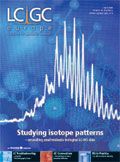ExTech and HTC-9
LCGC Europe
Is it possible to combine a serious scientific meeting together with social events and fun? Well if it is possible then the ExTech and HTC-9 meeting held in York, UK between 6?10 February came very close.
Is it possible to combine a serious scientific meeting together with social events and fun? Well if it is possible then the ExTech and HTC-9 meeting held in York, UK between 6–10 February came very close.

Both these three-day meetings were organized by the Royal Flemish Chemical Society (KVCV, Chair Robert Smits) and the Chromatography and Electrophoresis Group (C&EG, Chair Tom Lynch) of the Royal Society of Chemistry (RSC) and held in the Moat House Hotel in York. Overall the blend of formal lectures and informal presentations, with time for discussion and social events proved very successful. The format of having all delegates in the same hotel as the lectures, the exhibition and poster space worked really well as it provided the opportunity for people to meet, talk and drink together.
ExTech
ExTech started on 6 February and as would be expected microextraction techniques were the rule but good lectures were given on liquid-phase microextraction (LPME) as detailed by Knut Rasmussen and Stig Pedersen-Bjergaard (Oslo). In his lecture Stig showed how using polypropylene tubing (cheap, disposable!) crimped at one end gave excellent results. For GC the tubing is pre-washed with acetone and extraction is into a water-immiscible solvent such as octanol or dihexyl ether contained in the lumen of the tube. To reinforce the message Hian Lee (Singapore) outlined LPME applications in environmental analysis, and the role of simple liquid–liquid extraction in handling plasma and brain microdialysate and tissue in conjunction with HPLC-ESI-MS–MS was discussed by Mareika Lutz (AstraZeneca, Sweden).

Jim Jorgenson is presented a "Lifetime Achievement Award" by David Hills, editor of LCGC Europe.
Increased automation is an important goal discussed by many speakers and bioanalytical applications of solid-phase microextraction (SPME) were discussed at length by Janusz Pawliszyn (Waterloo, Ontario, Canada) and Jochen Schubert (Rostock, Illinois, USA). Even in vivo sampling was mentioned; the small amount of analyte removed being a major consideration if sampling in young children. Immersion SPME is an equilibrium technique and the problem of residence time has been addressed by pre-equilibration with an internal standard and then measuring both analyte uptake and IS loss. The problem of protein binding seems more intractable (SPME measures "free" analyte), and there are vanishingly few indications for "free" drug measurement. Headspace SPME, in contrast, seems exciting as it is not an equilibrium technique but offers the ability to concentrate vaporized or aerosolized analyte prior to transfer to GC, for example, and as such offers advantages over headspace GC per se. With salting out, non-volatile analytes such as amitriptyline can be detected in postmortem blood using conventional HS-SPME — a newly-developed cooled HS-SPME probe could further advance this area and give good sensitivity with volatiles such as amphetamine at the same time. Single drop microextraction (SDME) using a non-volatile or immiscible solvent and thin-film microextraction using poly(dimethylsiloxane) sheet represent further variants on the theme.
Listening to a number of speakers it did seem that on-line use of ideas developed from HPLC and SPE in bioanalytical sample preparation is the way forward. Preparation and use of molecularly imprinted polymers (MIPs), sol-gel and other immunoaffinity columns in SPE for targeted analytes in environmental samples was discussed by several speakers including Valérie Pichon (Paris), Margit Cichna-Markl (Vienna) and Carine Maisonette (Paris).

Jim Jorgenson presenting his lecture
On talking to Professor Dean, one of the organizers and presenters in the ExTech meeting, his overall impression was that "The meeting provided an excellent opportunity for scientists from around the world to meet and discuss extraction techniques and their applications in the beautiful city of York. Features of the 8th ExTech included the excellent oral presentations, focused tutorials, dynamic short courses and inclusive group discussion sessions."
The winner of the best poster award sponsored by the RSC C&EG was Lucia Sanchez-Prado (Universidad de Santiago de Compostela, Spain) for her poster entitled "Study of the sunlight photo-decomposition of five PBDEs by photo-SPME". The prize was a grant to cover registration and expenses to attend ExTech 9 to be held in Ĭesund, Norway, 3–6 June 2007.
HTC-9
Opening HTC-9 on Wednesday 8 February Keith Bartle (Leeds) welcomed everyone to Yorkshire. He expected that all the people who attended HTC-8 in 2004 knew what to expect after they had all been trained into singing the Yorkshire national anthem at that conference.
In the first lecture Professor Sandra described the challenging tasks in monitoring endocrine disrupting chemicals and outlined several methods for analysis together with in-situ derivatization before SE enrichment. Professor Sandra emphasized how this was ongoing work in his laboratory and invited everyone to the International Symposium on Capillary Chromatography in Riva Del Garda, Italy starting on 29 May where he will present his latest results.
The dominant theme was set straight away in the use of various forms of one-, two-, and even three-dimensional chromatography, often linked with MS, (is that another dimension?) to the analysis of complex mixtures, often with no particular analyte in mind. The matrices used included harbour sediments, soil from beneath oil storage facilities, river water, stored food, human urine, exhaled air, protein digests and herbal remedies. Clearly analyte or at least group identification/quantification is a primary aim but overall the work is similar to looking for the proverbial needle in a haystack. In part this reflects the search for insights into perceived problems such as endocrine disruption but more speculative aims include preclinical diagnosis of disease.
Other presentations in HTC did feature targeted analytes or groups of analytes, or specific problem areas. The question of how to cope with quantification in HPLC in the absence of reference material during pharmaceutical development, for example, was tackled by Ian Mutton (GSK). The evaporative light-scattering detector (ELSD), the chemiluminescent nitrogen detector (CLND), and the charged aerosol detector (CAD) had been compared with a proton NMR reference method — only the ELSD gave inconsistent results. The size of the task and hence the value of simple methodology is clear because hundreds of thousands of "new chemical entities" (NCEs) are synthesized for testing every year, a fact which reinforced comments from the environmental analysts as to the range of ex-NCEs continually being marketed and about which they are given no advance information. The problems posed by identification and quantification in the absence of reference material is not limited to pharma development, and Ian Sanders (Bruker) outlined work on accurate mass measurement (± 0.002 m/z) in HPLC–MS using ESI–TOF instruments using illustrations from forensic toxicology.1
By the end of the second day of HTC many people were in different dimensions after hearing lectures on one-, two-, three- and maybe four-dimensional chromatography/separations or was it a function of the excellent Yorkshire beer? For the late afternoon discussion there was a light hearted debate as to whether 2-D chromatography was a (comprehensive) waste of time, with Peter Myers complete in full-bottomed wig and scarlet robe acting as judge (and some thought jury too!). Peter Scheonmakers made the case that we did not need multidimensional chromatography and Phillip Marriott opposed this view. Peter Schoenmakers' argument was based around the statement "Don't use comprehensive two-dimensional separations if you just want to separate a few peaks."
At the end of the debate and after one of Phillip Marriott's students was removed from the temporary court room by Bailiff Bob for refusing to answer a direct question the audience was fairly evenly divided when it came to a vote. But on the ruling of the judge the verdict was given to Peter Schoenmakers.
Sometimes on the last day of a conference it can feel that people are just ready to go home but not with this conference. We do not think that we have seen so many people staying until the very, very end. But then on the last day the participants were treated to an excellent set of lectures.
To start the last session Peter Schoenmakers made us all think in showing that with one-dimensional LC you can scrape your way to a peak capacity of 100, maybe 200.
With LC×LC you can (easily) get into the thousands. But you should think about what you are doing and don't use comprehensive two-dimensional separations if you just want to separate a few peaks or indeed just because you can.
The final lecture was presented by Jim Jorgenson and before his lecture he was presented with a "Lifetime Achievement Award" by David Hills, the editor of LCGC Europe (pictured).
Jim dedicated his lecture to Cal Giddings who suggested to Jim in 1987 that he should consider two-dimensional separations as a more efficient approach to resolving complex mixtures.
Jim showed the results of this in his lecture on the LC–LC, LC–CE and other combinations that have been well published and now recognized with the Life Time Achievement award.
The HTC award (sponsored by Elsevier) was presented to Luigi Mondello for his lecture on a new comprehensive approach for the analysis of real samples. In supporting this prize Platinum Wines also presented Luigi with a giclee print of York Minster.
And Finally...
As many readers will appreciate a report from the pens of Myers and Flanagan would not be complete with out some of their personal comments.
Even a well run conference like ExTech and HTC had problems with parallel lecture sessions. It is very difficult to get them to work. Maybe it would be better to reduce the number of presentations to one excellent stream.
On viewing some presentations you could be excused for thinking that they must be a prize for the most complex slide. Why do so many people continue to cram so much onto their slides, use dark colours and fussy backgrounds? Just because complex dark backgrounds are provided in the presentation software doesn't mean they have to be used! Sometimes, well most of the time, simple is best.
And finally presenters should remember that a lecture hall is a different environment from a lecture room and from a business seminar.
If the conference had one overall message both from the science and presentations it was "Think; don't use the complex method if the simple method will work."
This was an extremely friendly meeting; science was given due prominence, and the ancient City of York at the centre of Yorkshire played its part in providing an elegant backdrop.
Sabeth Verpoorte told us that, "HTC is one of my favourite meetings. As soon as I walk in, I feel very much at home."
Congratulations to everyone from the organizers to the speakers to the delegates.
Peter Myers is the MD of X-tec Consulting Ltd. His current interests are new support materials for chromatography and new separation methods involving the integration of electronics in hybrid separation techniques, computing and scientific photography.
Bob Flanagan is consultant clinical scientist at the Medical Toxicology Unit, Guy's and St Thomas' NHS Foundation Trust, London, UK. His current interests are therapeutic monitoring of antipsychotic drugs in addition to training and accreditation in analytical toxicology.
References
1. Ojanperä et al., J. Anal. Toxicol., 29, 34–40 (2005).
Altering Capillary Gas Chromatography Systems Using Silicon Pneumatic Microvalves
May 5th 2025Many multi-column gas chromatography systems use two-position multi-port switching valves, which can suffer from delays in valve switching. Shimadzu researchers aimed to create a new sampling and switching module for these systems.
Studying Cyclodextrins with UHPLC-MS/MS
May 5th 2025Saba Aslani from the University of Texas at Arlington spoke to LCGC International about a collaborative project with Northwestern University, the University of Hong Kong, and BioTools, Inc., investigating mirror-image cyclodextrins using ultra-high performance liquid chromatography–tandem mass spectrometry (UHPLC–MS/MS) and vibrational circular dichroism (VCD).

.png&w=3840&q=75)

.png&w=3840&q=75)



.png&w=3840&q=75)



.png&w=3840&q=75)











